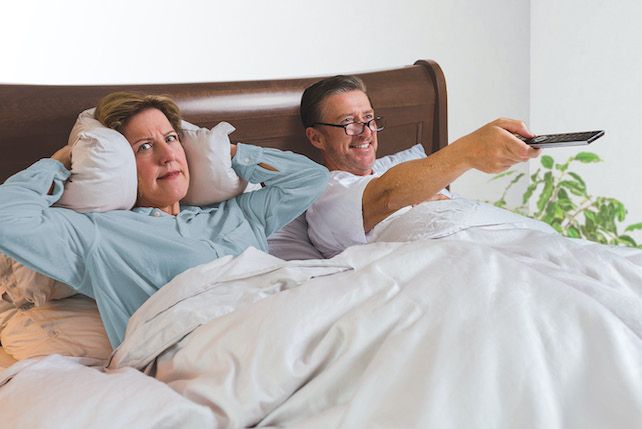
November 12, 2021Tools that can make day-to-day life easier for people with hearing loss
Every day comes with its struggles for people who are deaf and live with hearing loss. There are actually side effects of dealing with a hearing loss, especially if left untreated. Often they deal with listening fatigue and an increased risk of burnout, which can be linked to mental health issues. But there are solutions available and technology is advancing every day to improve the well-being of the deaf and hard of hearing community.
We have laid out various tools and techniques you can start using to limit side effects and start improving your day-to-day life.
## Communication strategies
Each hearing loss is unique, but the recommended forms of communication are the same and if practiced, can truly make a difference.
Those with hearing loss rely on their vision to take body language cues and listening to fully understand language. Since they’re already good at lip-reading, making sure you have their attention and there is a direct line of sight to the person you are speaking with is essential.
Reducing background noise as much as possible will make it easier to focus on what someone is saying rather than listening to everything at once. You can turn down the volume on the TV or move to a quieter area if necessary.
Tell people you have a hearing loss. People will usually understand and make an effort to accommodate, but you have to communicate your needs whether it’s asking them to speak louder, mumble less or enunciate their words more.
Tell people you have a hearing loss. Often, others will understand and make an effort to accommodate, but you have to communicate your needs to see improvement. Asking someone to speak slower, focus on enunciating consonants and speak towards you are ways to help their voice sound clearer.
Consonants fall into the frequency where hearing loss lives, which is why it’s difficult to hear the sounds such as ‘th’, ‘ch’, ‘f’ or ‘sh’ because you can’t define what the words are. Sometimes if they are speaking a bit louder it can help, but if they start yelling it only becomes more difficult and stressful.
## Apps
There are tons of apps on the market that are helpful for the deaf and hearing loss community in all kinds of situations where it can be difficult to hear.
Google released an app called Live Transcribe. It uses ASR technology to turn spoken words into text on an android phone screen in real-time. It works for 70 different languages and all it needs is a network connection. The app could be very helpful in situations such as live conferences, meetings or loud spaces when ordering a coffee.
Rogervoice, an essential app for those who are deaf and hard of hearing, produces a live transcription of phone calls and delivers the transcription directly to your phone. Similarly, Voxci transcribes voice mails and sends them to you via email or text.
TapSOS comes in handy during emergency situations and it won the AbilityNet Tech4Good Digital Health Award. By using this highly visual and interactive app, people that are deaf and those with hearing loss can communicate with emergency services without having to listen or speak. Its features include stored medical history and important personal information as well as GPS tracking to pinpoint locations.
Learn more or book an appointment today by visiting nexgenhearing.com.
Sources:
[http://hearing.wustl.edu/Hearing-Education-Center/Communication-Strategies/Strategies-for-the-Hearing-Impaired-Listener](http://hearing.wustl.edu/Hearing-Education-Center/Communication-Strategies/Strategies-for-the-Hearing-Impaired-Listener)
[https://www.starkey.com/blog/articles/2015/07/listening-fatigue-1](https://www.starkey.com/blog/articles/2015/07/listening-fatigue-1)
[https://www.hearatlanta.com/hearing-loss-articles/what-are-the-dangers-of-hearing-loss/](https://www.hearatlanta.com/hearing-loss-articles/what-are-the-dangers-of-hearing-loss/)
READ MORE 
November 9, 2021Signs of Hearing Loss in Each Stage of Life
Hearing loss can affect people of all ages for various reasons such as genetics, exposure to loud noises, presbycusis, autoimmune issues and sometimes ototoxic medications. More dangerously, untreated hearing loss can cause issues, often psychological, which also tend to be the indicators.
If you’re concerned that you or a loved one may have hearing loss, here’s a list of signs in each stage of life that may indicate a hearing loss.
## Children
Signs of hearing loss in children often go unnoticed, hence it’s important to look for signs as early as infancy for quick treatment. If a hearing loss isn’t indicated now, it’s still a possibility as they age.
Here are some of the signs to watch for:
Lack of attention to sound and sound localization
Delayed speech development
Unable to monitor their own voice or follow verbal instructions
Behavioural changes and hyperactivity
Poor school performance
## Teenagers
Diagnosing teens is easier because they’ve developed communication skills. Personalities influence any diagnosis because they affect our verbal interactions and reactions to different situations.
The following are some indicators:
- Struggles with verbal cues and instructions
- Often ask people to repeat themselves
- Lack of participation in school activities, poor school performance
- Isolated from social situations
- Behavioural changes – may act out or do nothing at all
## Adults and Seniors
- In adults, signs of hearing loss present differently with age due to developed coping mechanisms. Seniors often lose their hearing as they age, but they can take action to treat it for a better quality of life.
Here are signs to look for:
- Regularly ask people to repeat themselves
- Talk very loud or quiet
- Difficulties understanding verbal communication
- Isolate themselves in noisy environments and don’t participate
- May present with depression or anxiety
- Complaints of dizziness, ringing in ears and exhaustion
If you’re concerned about hearing loss affecting you or a loved one, NexGen Hearing provides free hearing tests and hearing aid consultations, sales and fittings. NexGen Hearing’s team is dedicated to helping you find solutions and discussing your hearing needs, goals and options to find the best outcome and support you every step of the way.
READ MORE October 12, 2021What is the best hearing aid on the market 2021
Purchasing hearing aids is an important and expensive investment to make, especially when you pay for what you get. The various brands, styles and features give people an opportunity to select a hearing aid that suits their lifestyle, hearing loss and preferences to personalize their hearing experience. Hearing aids are vast in their capabilities and features. For example, there are rechargeable hearing aids, automatic noise adjusting aids, Bluetooth pairing, tinnitus masking and much more. Every person is unique so naturally, hearing aids need to be unique for each individual.
When looking for hearing aids, consult a hearing professional for a test to determine your hearing abilities, get recommendations and insight into your options. With their experience and knowledge, they can help navigate the tricky world of hearing aids. They will program your hearing aid to optimize and enhance your hearing experience. Next, think about what features are most important to you. Do you want non-visible hearing aids? Do you want to minimize background noise as much as possible? Do you want sounds from a phone or cinema, for example, to stream directly to your hearing aids? These are all questions to ask while looking for your perfect hearing aids.
Once you have an option in mind, it’s a good idea to ask about a trial period to ensure your hearing aid of choice is a good fit in day-to-day life. Wear them every day in different environments, test out the features multiple times to get a feel for how the hearing aids function and push through the awkward adjustment period. It’s normal for new hearing aids to sound weird, overly loud and startling, but as they’re used more, certain features may turn out to not be what you thought. The style may be uncomfortable or unrealistic and you might realize there is a different type of hearing aid that will better suit you. Following up with your hearing professional will help to find out if the hearing aid needs a programming adjustment to filter certain sounds in and out or if a different hearing aid is needed.
## NexGen Hearing Professional’s Top Pick and Best First-time Hearing Aid
### Oticon More1 - Premium
**Noteworthy pros and cons:**
● Deep Neural Network programming significantly improves the listening experience for the user
● Audiologists have more adjustment handles to match specific hearing loss targets
● On-the-go-charger case with a battery life of 3 days and a desk charger
● Most repairs such as battery issues can be fixed in your clinic
● Tinnitus Care streams broadband sounds or nature sounds to mask tinnitus
● Incompatible with single-sided deafness
● The app only allows generic control in real-time, custom programs can’t be saved
The Oticon More1 hearing aid is a revolutionary device that features a new, more powerful processing platform called Polaris, uses a different philosophy than other manufacturers and functions based on a Deep Neural Network. Oticon built the More hearing aids with the BrainHearing approach, which essentially intakes all sounds from all directions, amplifies the important information it’s receiving, then maximizes the amount of amplification, greatly increasing the amount of sound going into the user’s ears. The Deep Neural Network was developed using Deep Learning, a subset of Machine Learning and Artificial Intelligence (AI). The dynamic system has been trained with over 12 million sound samples recorded from real environments for the hearing aid to learn which sounds are important to amplify and which are not. The More 1 delivers 30% more sound to the brain, increases speech understanding by 15% while also reducing the user’s overall listening efforts in comparison to Oticon OPN S, according to a [study from Oticon](https://wdh01.azureedge.net/-/media/oticon/main/pdf/master/whitepaper/71933uk_wp_oticon-more_clinical_evidence_a-glimpse-into-new-brainhearing-benefits.pdf?la=da-dk&rev=DDDD&hash=6178AB98C380253E4C19D9BEC397B73C).
Audiologists have 20 adjustment handles to match specific hearing loss targets with the More 1, significantly more than any other manufacturer in the industry, making it much more effective when programming the hearing aids. In the Oticon ON app, audiologists can host live remote care sessions to make programming adjustments which are particularly helpful for people with mobility issues or other factors preventing them from going into the clinic.
For users, in addition to the HearingFitness, Internet of Things, remote control of the sounds in front of you such as volume and sound boosters for conversation, there is now a 3 Band Streaming Equalizer to adjust the bass, mids and treble for streaming. These are made for iPhone hearing aids but now feature the ASHA Bluetooth protocol for Android devices (Android 10 or more and Bluetooth version 5 for direct streaming). They’re future-proof and will be compatible with LE Audio/Bluetooth.
The Oticon More model is available in 3 versions. They are available in a variety of colours to match hair or skin tone as well as pink. Compatible with mild-severe hearing losses, the rechargeable devices last for 16 hours, including 4 hours of streaming, after a 3-hour charge. The More 1 model is the premium hearing aid from the line, reducing the most background noise with the most sound capabilities. The More 2 and More 3 don’t reduce as much background noise as the More 1 but include all of the other features for a much more affordable price.
## Best Invisible Hearing Aid
### Starkey Livio Edge AI - Premium
**Noteworthy pros and cons:**
● Edge Mode optimizes the listening experience
● Thrive App is comprehensive and automated
● Bluetooth connection is not hands-free
The Starkey Livio Edge AI hearing aids are rechargeable, offer various custom in-the-ear styles for each of the 5 tiers and a selection of colours. This model is a new-and-improved version of the Livio Edge hearing aids with features that significantly upgrade the user’s experience.
The most innovative feature is Edge Mode which utilizes AI to optimize the user’s ability to hear in complex listening situations such as a noisy stadium. By tapping on the hearing aid, voices will sound clear and prominent while the background noise is reduced. It’s activated and unactivated whenever the user wants.
The Bluetooth feature connects to all smart devices, unlike the previous Livio AI model. Any form of audio can be streamed directly to the hearing aids as well as Starkey assistive listening devices. These include a remote microphone, table microphone, remote control and TV streamer, all with the potential to greatly improve streaming and listening.
The Thrive App is comprehensive and offers automation features that are unheard of in the industry. For hearing aids it allows access to control the volume, frequency, ALDs, streaming volume, hearing aid microphone volume and more. It also includes tracking the user’s heart rate, brain score, body score, Find my Hearing Aid, hearing aid self-check, language translation and users can talk to the app like it is Siri or Google Home for information, as well as many other features. In the health section of the app, there is an option to name an emergency contact. The hearing aids have motion sensors and fall detection meaning that if the user took a fall, a notification can be sent to their emergency contact for help.
## Best for Children
### Phonak Sky Q - Standard
**Noteworthy pros and cons:**
● 4 models for different types of hearing loss
● ALD compatible in all situations necessary
● Durable and adaptive
Designed specifically for children, these hearing aids won’t slow them down or affect their childhood. Instead, the Phonal Sky Q provides the technology needed for children to lead normal lives despite their hearing loss. They automatically adjust to your child’s environment in all situations to optimize their listening experience, direct phone calls to their hearing aids, are resistant to dust, water and sweat, mix & match colour palates of the whole rainbow, various styles suitable for certain lifestyles, and they feature a Rogers receiver, compatible with assistive listening devices (ALD) that may be used in the classroom or at home.
## Best Budget Hearing Aids
### Oticon Siya - Entry-Level
**Noteworthy pros and cons**
● Comfortable to wear
● High-quality technology that is affordable
● Doesn’t include modern features from other Oticon models
Developed by Oticon, the Siya model is available in two models, Siya 1 or Siya 2, as well as a variety of in-the-ear custom styles and colours. The invisible styles are perfect for those who prefer a subtle appearance. As entry-level hearing aids, they perform exceptionally well, capturing and amplifying the natural sounds around us while maintaining authenticity in sound. Speech is clear and easy to understand, background noise is reduced greatly and the hearing aids offer connectivity features similar to other Oticon models.
The Siya’s can connect wirelessly with ease to Apple devices, TV, laptop, tablet and more for high-quality streaming at any time. By syncing the hearing aids to preferred devices, they can easily connect while users are on the go. The Oticon ON app provides users with the ability to regulate their hearing aid’s volume and interchangeable programs through remote control, among other features.
## Best Connectivity and Streaming
### Phonak Audeo Paradise - Standard
**Noteworthy pros and cons**
● Exceptional connectivity abilities with hands-free phone calls and multiple Bluetooth connections.
● Motion Sensors improving the listening experience with automatic adjustments
● Every time the user gets a notification on their phone, the hearing aids kick into Bluetooth streaming mode and cancels the custom program, reverting to AutoSense on the MyPhonak App. When connecting the hearing aids to an audiologist’s computer, the custom programs get wiped out.
One of the newest hearing aid lines Phonak released is the Audéo Paradise. Available in all styles and rechargeable or replaceable battery options, the hardware is cutting edge. In addition to the original features of the Marvel hearing aids, the Paradise devices include motion sensors, exceptional connectivity, an updated myPhonak app and AutoSense OS 4.0, among other features.
Motion sensors can identify the user’s movements and acoustics to automatically adjust its microphone for each environment. If the user is going for a run, eating dinner in a loud restaurant or attending a lecture, the hearing aids are capable of determining the source of sound and optimizing it.
They can be paired to 8 different devices and 2 at the same time such as your phone, laptop, TV or ALD. Hands-free phone calls are now possible with a simple double tap on your ear to accept or cancel calls after the hearing aids announce the phone number or contact of who’s calling. The microphones at the back of the hearing aids pick up the user’s voice throughout the phone call and you can ask to make a phone call without touching your phone once.
Phonak updated the myPhonak App to allow users more access to their hearing aids than ever before. They can adjust the volume, customize the audio, frequency, noise reduction, speech focus and more, then save the settings as a custom program to use in the future. Plus, the ability to have remote appointments with their audiologist such as programming sessions or hearing tests is a unique feature.
The new AutoSense OS 4.0 added dynamic noise cancellation, speech enhancement and more to enhance the users listening experience by allowing noise-cancelling customization and amplifying people’s voices so users can catch everything in their unique day-to-day surroundings.
Learn more or book an appointment today by visiting [nexgenhearing.com](/).
Sources:
[https://www.hearingaidknow.com/a-review-of-oticon-more-1-hearing-aids](https://www.hearingaidknow.com/a-review-of-oticon-more-1-hearing-aids)
[https://www.oticon.ca/hearing-aid-users/hearing-aids/products/product-details?productId=255443](https://www.oticon.ca/hearing-aid-users/hearing-aids/products/product-details?productId=255443)
[https://www.starkey.com/hearing-aids/livio-edge-artificial-intelligence-hearing-aids?correlationId=cc36a7cc-4fc6-4fa1-b3ea-d2395ee8e560](https://www.starkey.com/hearing-aids/livio-edge-artificial-intelligence-hearing-aids?correlationId=cc36a7cc-4fc6-4fa1-b3ea-d2395ee8e560)
[https://www.phonak.com/us/en/hearing-aids/phonak-sky-q.html](https://www.phonak.com/us/en/hearing-aids/phonak-sky-q.html)
[https://www.youtube.com/watch?v=w0uFiHl3UY4](https://www.youtube.com/watch?v=w0uFiHl3UY4)
[https://www.oticon.com/solutions/siya](https://www.oticon.com/solutions/siya)
READ MORE 
September 8, 2021How Do I Convince My Spouse to Get a Hearing Test?
In all my years as a hearing health care professional, this is one of the most common and difficult questions to answer. The vast majority of people living with hearing loss are either unaware of their hearing difficulties or do not fully realize the extent of their hearing loss. The number one reason prompting people to get their hearing checked is family members who have grown frustrated living with someone who has hearing loss. Unfortunately, there are many husbands and wives who resist and persist! It’s often a very sensitive topic for retired couples spending so much time together.
When someone has mild-to-moderate hearing loss, typically they will hear relatively well if you are talking to them face-to-face in a quiet environment, but will not hear well if you are walking away from them, are in a different room, or if there is some other noise that is interfering with your voice. The hearing-impaired individual will quite often say, “How can I hear you when you’re talking into the fridge?” or “How can you expect to be heard when you talk so softly?” Repeatedly asking others to “please say it again” is a strong indicator that some form of hearing loss exists.
Unfortunately, trying to convince someone that the reason they keep asking people to repeat themselves is because their hearing ability is at fault can seem impossible at times. Don’t give up! It can take a few years for people to accept the fact that their hearing is deteriorating, and they need hearing aids. People may find it difficult in part due to the lingering stigma that wearing hearing aids is effectively admitting you’re “getting old”. Ironically, the symptoms of hearing loss become more prominent and obvious when hearing aids are not used, drawing people to that precise conclusion. Today’s technology allows for the discreet use of hearing aids.
What I suggest is to lovingly explain to your husband or wife that you are growing increasingly frustrated with having to repeat yourself as frequently as you are. Then, let them know that for a one-week period, you are going to notate every time you need to repeat yourself. I would also set the volume on the TV to a certain level, and then track the number of times they need to increase the volume so they can comfortably hear. After 7 days, discuss the results, and gently encourage them to get a hearing assessment, even if it is just to get a baseline of their hearing. You may be fearful that you are nagging them, but you will be doing yourself and them a big favour in the long run.
When they are finally ready to come in for a complimentary hearing assessment, the hearing health professionals at NexGen Hearing will be ready to answer any question or concerns they may have. Learn more or book an appointment today by vising [nexgenhearing.com](https://www.nexgenhearing.com/)
READ MORE 
August 4, 2021Dreaming of a post-covid vacation? Tips and Trends for Travelling with Hearing Loss
Everyone is eagerly awaiting the chance to start travelling again as the possibility is looking brighter each week. A post-COVID vacation could come with stress for the average person, let alone someone who is deaf or hard of hearing.
People who deal with hearing loss have very different travel experiences than those with normal hearing whether its pre or post-COVID. It’s usually extremely stressful, agitating and difficult, but it doesn’t have to be.
So many destinations are becoming more inclusive to provide better accommodations for people with hearing loss so they can have a much more positive experience in their travels.
Australia provides an “Experience Australia in 8D Audio” video series that gives listeners the illusion of sound all around them in each particular scene. It provides people with hearing loss a vivid and immersive listening experience that is normally very uncommon for this community.
Other popular destinations with excellent opportunities for the hearing community are New York City, Disney World, cruises, Cairns and France. They all provide specialized tours, accommodations and services for the deaf and hard of hearing.
Here are a few tips in preparation for your trip:
READ MORE Plan in advance
If you have a framework of what your travels will look like and set up accommodations, reservations, tours etc. to best suit your hearing loss, you can avoid dealing with communication issues during your trip.Make the most of technology
Download relevant apps such as Maps, translation, transit and more. Any apps that can assist you during your travels can be extremely helpful.Advocate for yourself
Don’t be afraid to tell people you have a hearing loss. Since hearing aids can be so discreet, most people wouldn’t know you are wearing one. Once people are aware, they can take steps to communicate with you effectively.Pack extra supplies
Bring extra packs of batteries, cleaning supplies, cases and other important supplies to ensure that if a battery dies or a tube gets clogged, you can manage this on the go. Before leaving contact your local NexGen Hearing clinic to order extra supplies. www.nexgenhearing.com.
July 7, 2021What To Expect in An Ear Wax (Cerumen) Removal Procedure
Cerumen – commonly referred to as ear wax – is a natural secretion by the human body and is actually very beneficial and serves an extremely important purpose. Individuals with too little ear wax are likely to be prone to ear infections and itchy ears. And while cerumen is good for your ears, there can be too much of a good thing. Too much earwax can cause other problems, which can threaten the health of your ears. If you experience any of the following symptoms: hearing loss, sensation of stuffiness or fullness in ear canal, ear ringing (tinnitus), persistent itching or discharge, you should seek attention from a hearing care professional such as an audiologist, who may recommend an Ear Wax Removal Procedure.
The process begins with a visual inspection of the ear canal using an Otoscope. The audiologist might even use a Video Otoscope, which is a special tool that displays a view of the inside of your ear on a computer screen. This allows you to see inside your ear as well. If necessary, ear wax removal drops may be put into the ear to help soften the ear wax. To remove the wax, the audiologist will use a handheld irrigator, to spray warm water into the ear. During the procedure, the patient will hold an irrigation bowl to catch the ear wax and water that will be draining from the ear. The special nozzle on the irrigator allows the water to spray laterally, instead of directly down the ear canal. If any wax remains in the ear after the irrigation procedure, a lighted ear curette might be used to gently scrape out the additional wax from the sides around the entrance of the ear. If the video otoscope is used, the audiologist can display the difference AFTER the ear wax has been removed from the ear.
The audiologist will complete the ear wax removal process in the other ear. In some cases, wax can clog hearing aid tubes or other parts of your hearing aids. This buildup can be removed by the audiologist. Removing your ear wax will also help prevent wax from being deposited into hearing aids, to keep them working well!
To see what is involved in an ear wax (cerumen) removal procedure, performed by our hearing professional, Adam Medeiros, click here: View YouTube Video
READ MORE 
